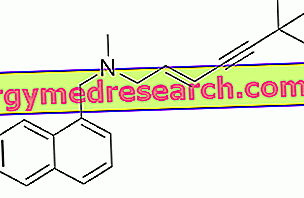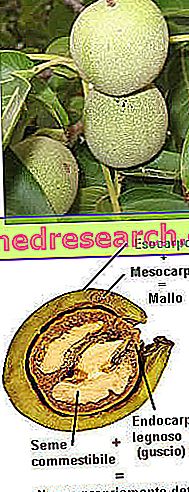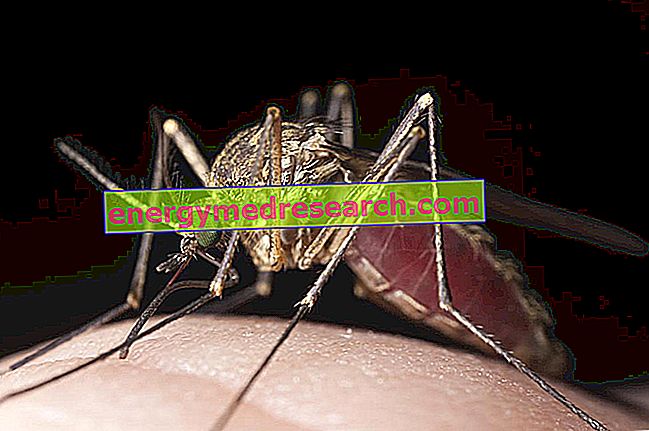Terbinafine is an antifungal drug very useful in the treatment of fungal infections of the skin and nails.
From a chemical point of view, terbinafine is an allylamine.

Terbinafine - Chemical Structure
Terbinafine is available in the form of pharmaceutical formulations suitable for oral administration and topical administration.
Indications
For what it uses
The use of terbinafine is indicated for the treatment of:
- Onychomycosis (oral administration);
- Ringworm, ringworm of the groin and ringworm of the foot (oral and topical administration);
- Fungal infections of the genus Candida (oral and topical administration);
- Tinea versicolor (topical administration).
Warnings
During all oral terbinafine treatment, liver function must be constantly monitored. If any symptom indicating a possible abnormal liver function appears, treatment with terbinafine should be stopped immediately.
A great deal of caution should be used when administering oral terbinafine in patients with pre-existing psoriasis or systemic lupus erythematosus.
The pharmaceutical forms of terbinafine suitable for topical administration must be used only and exclusively externally. It is therefore necessary to avoid contact with the mouth, eyes and damaged skin.
Oral terbinafine can cause side effects that can alter the ability to drive vehicles and / or use machinery, therefore, great care must be taken.
Interactions
There are no known drug interactions between topical terbinafine and other drugs. However, other medicines should not be applied to the area of skin treated with terbinafine.
Instead, before starting oral terbinafine treatment, you need to tell your doctor if you are taking any of the following medications:
- Cimetidine, a drug used to reduce acid secretion of the stomach;
- Amiodarone and other antiarrhythmic drugs;
- Fluconazole or ketoconazole, other antifungal drugs;
- Rifampicin, an antibiotic;
- Tricyclic antidepressants ;
- Selective serotonin reuptake inhibitors (or SSRIs ), antidepressant drugs;
- Beta-blocking drugs;
- Type B monoamine oxidase inhibitors (or MAOIs-B ), drugs used in the treatment of Parkinson's disease;
- Dextromethorphan, an antitussive;
- Caffeine ;
- Cyclosporine, an immunosuppressive drug.
In any case, it is still advisable to inform your doctor if you are taking - or have recently taken - any type of medication, including medicines without a medical prescription and herbal and / or homeopathic products.
Side effects
Terbinafine can cause various side effects, although not all patients experience them. This depends on the sensitivity that each individual has towards the drug. Therefore, it is not said that the undesirable effects are all manifested with the same intensity in each person.
The main adverse effects that may occur during terbinafine treatment are listed below.
Blood and lymphatic system disorders
Terbinafine therapy can cause changes in the blood and lymphatic system (the system responsible for the synthesis of blood cells). These alterations can give rise to:
- Anemia;
- Leukopenia, ie the reduction in the number of leukocytes in the blood;
- Agranulocytosis, ie the decrease in the number of granulocytes in the bloodstream;
- Piastrinopenia, ie the decrease in the number of platelets in the bloodstream.
Pathologies of the central nervous system
Treatment with terbinafine may cause:
- Aching head;
- dizziness;
- Alteration or loss of the sense of taste;
- paresthesia;
- Hypoaesthesia;
- Alteration or loss of the sense of smell.
Hepatobiliary disorders
Terbinafine therapy may cause increased blood levels of liver enzymes, liver failure, hepatitis, cholestasis and jaundice.
Gastrointestinal disorders
Treatment with terbinafine may favor the onset of:
- Sense of fullness;
- Dyspepsia;
- Nausea;
- Diarrhea;
- Abdominal pain;
- Pancreatitis.
Skin and subcutaneous tissue disorders
Terbinafine therapy can cause:
- Skin rash;
- Urticaria;
- Photosensitivity reactions;
- Stevens-Johnson syndrome;
- Toxic epidermal necrolysis;
- Erythema multiforme;
- Exfoliative dermatitis;
- Bullous dermatitis;
- Psoriasiform skin eruptions;
- Exacerbations of psoriasis in patients who are affected;
- Alopecia;
- Drug rash with eosinophilia and systemic symptoms (DRESS syndrome).
Other side effects
Other side effects that may occur during treatment with terbinafine are:
- Allergic reactions, even serious, in sensitive individuals;
- Loss of appetite;
- Body weight loss;
- Temperature;
- Fatigue;
- Flu-like symptoms;
- Systemic lupus erythematosus;
- Anxiety;
- Depression;
- Changes in vision;
- Decreased visual acuity;
- Hearing changes;
- Hearing loss;
- Tinnitus;
- vasculitis;
- arthralgia;
- Myalgia;
- Rhabdomyolysis.
Side effects typical of dermal administration of terbinafine
In addition to some of the side effects described above, the administration of terbinafine via the skin may also favor the onset of:
- Peeling of the skin and itching at the site of application;
- Skin lesions;
- Scab formation;
- Discoloration of the skin;
- Pain, redness, burning and / or irritation at the site of application;
- Skin dryness;
- eczema.
Overdose
If an overdose of oral terbinafine is taken, nausea, headache, dizziness and abdominal pain may occur. The administration of activated charcoal can be useful to reduce the absorption of the excess drug.
In any case, if terbinafine overdose is suspected, contact your doctor immediately or contact your nearest hospital.
Action mechanism
Terbinafine is an allylamine and, as such, carries out its fungicidal action by inhibiting squalene epoxidase.
Squalene epoxidase is an enzyme involved in the synthesis process of ergosterol, a sterol that is part of the plasma membrane of fungal cells.
The task of this enzyme is to convert squalene (a precursor of ergosterol) into squalene epoxide (another precursor of ergosterol) which - following other enzymatic reactions - will then be transformed into ergosterol.
Inhibition of squalene epoxidase causes:
- A reduction in the total ergosterol content within the fungal cell membrane, this causes alterations in the permeability of the membrane itself and malfunctions of the membrane proteins involved in nutrient transport and in the regulation of cellular pH;
- An accumulation of squalene inside the fungal cell which - when it reaches too high quantities - becomes toxic to the cell itself.
All this leads the fungal cell to an inevitable death.
Mode of Use - Posology
Terbinafine is available for:
- Oral administration in the form of tablets;
- Topical administration in the form of a cream, dermatological gel, dermatological solution or dermatological spray.
The dose of terbinafine to be administered and the duration of treatment must be established by the doctor depending on the type and severity of the infection to be treated.
Regardless of the use of oral terbinafine or topical terbinafine, it is very important to scrupulously follow the directions given by the doctor, both for what
regards the amount of drug to be used, both as regards the duration of the treatment.
Below are some indications on the doses of terbinafine usually used in therapy.
Oral administration
The oral terbinafine dose normally used in adults is 250 mg a day, to be taken in a single dose or in two divided doses.
In children over two years old, however, the dose of terbinafine usually used is 62.5-250 mg, to be taken once a day. The amount of drug to be taken varies according to the child's body weight.
Topical administration
Usually - regardless of the type of pharmaceutical formulation that is used (gel, spray, solution or cream) - it is recommended to apply terbinafine once or twice a day, according to the doctor's instructions.
Pregnancy and breastfeeding
Generally, the use of terbinafine by pregnant women is contraindicated, except in cases where the doctor does not consider it absolutely essential.
Furthermore, terbinafine is excreted in breast milk, therefore breast-feeding mothers should not take the drug.
In any case, pregnant women and breastfeeding mothers should always seek advice from their doctor before taking any type of medicine.
Contraindications
The use of terbinafine is contraindicated in the following cases:
- In patients with known hypersensitivity to terbinafine itself;
- Pregnant;
- During breastfeeding.
In addition, oral terbinafine should not be given to children under two years of age, whereas topical terbinafine should not be used in children and adolescents under 18 years of age.



